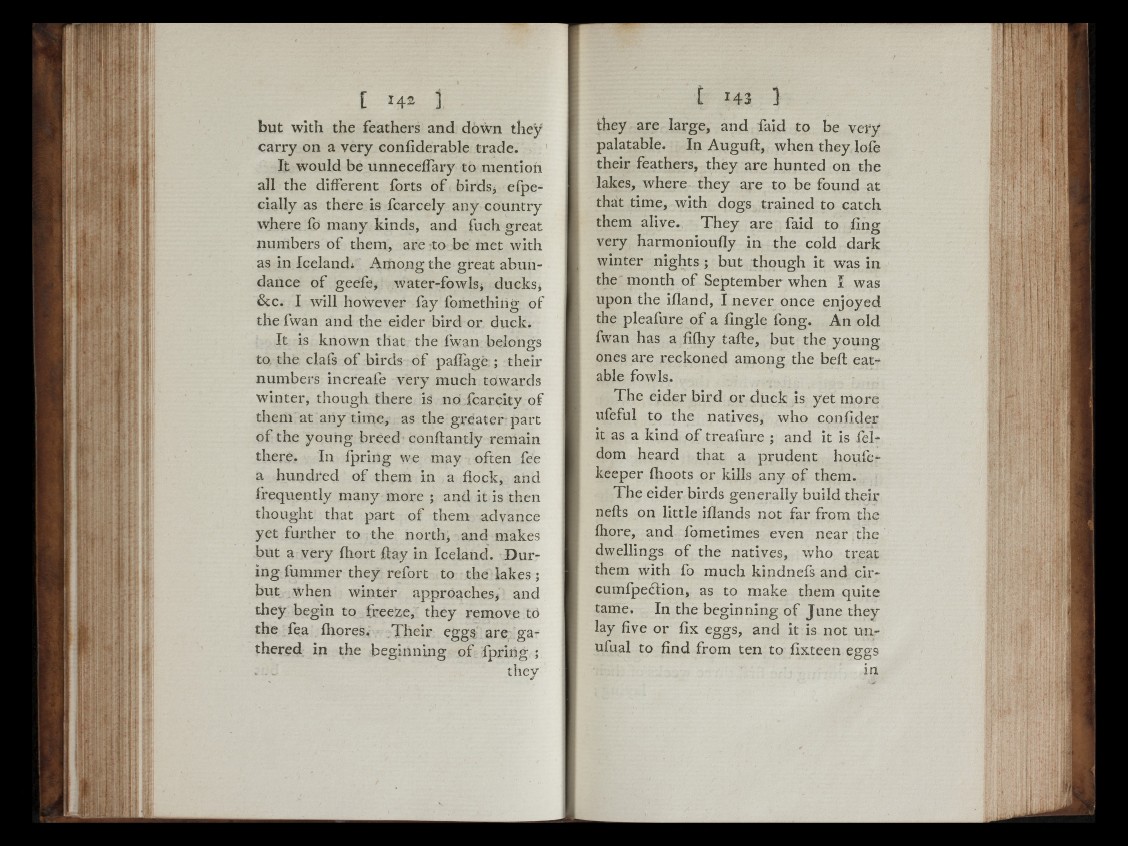
in':/'
■ifo:,
ill’s
i,|l lli!i
[ *('}
B$il
fit
G i i i M i i r f l l ! i P - 'S r - '•;■•"• '• I ..S- '^ '1 J
:::
: p F 1:3 «
‘I
G i l
f» ■' . I., 'lY
" Il i
'' #]' . *> / I 1 I
A-4 1 - . . " , ;
i
15 4 .1
. ill!
: r* )^-
, r‘.
.1 ' '■ ^ 1 <4 -*'? 1
n i f ‘ Ik.
.D¡" II
¡ J r
I : , " l
G ' i l
ift:S
U ' f m n
i 142
but with the feathers and down they
carry on a very coniiderable trade.
It would be unneceiTary to mention
all the different forts o f birds; efpecially
as there is fcarcely any country
where fo many kinds, and fuch great
numbers o f them, are to be met with
as in Iceland* Among the great abundance
o f geefe, water-fowls; ducks;
&c. I will however fay fomething of
the fwan and the eider bird or duck.
It is known that the fwan belongs
to the clafs o f birds o f paffage ; their
numbers increafe very much towards
winter, though there is no fcarcity of
them at any time, as the greater part
o f the young breed conftantly remain
there. In fpring we may often fee
a hundred of them in a fiock, and
frequently many more ; and it is then
thought that part o f them advance
yet further to the north, and makes
but a very iliort ftay in Iceland. During
fummer they refort to the lakes ;
but when winter approaches; and
they begin to freeze, they remove to
the fea Iliores. Their eggs are gathered
in the beginning o f ipring ;
they
[ 143
they are large, and faid to be very
palatable. In Auguft, when they lofe
their feathers, they are hunted on the
lakes, where they are to be found at
that time, with dogs trained to catch
them alive. They are faid to ling
very harmonioufly in the cold dark
winter nights ; but though it was in
the month o f September when I was
upon the iiland, I never once enjoyed
the pleafure o f a iingle fong. An old
fwan has a fiiliy tafte, but the young
ones are reckoned among the beft eatable
fowls.
The eider bird or duck is yet more
ufeful to the natives, who confider
it as a kind o f treafure ; and it is feldom
heard that a prudent houfe-
keeper ftioots or kills any o f them.
The eider birds generally build their
nefts on little iilands not far from the
fhore, and fometimes even near the
dwellings o f the natives, who treat
them with fo much kindnefs and cir-
cumfpe6Iion, as to make them quite
tame. In the beginning o f June they
lay five or fix eggs, and it is not unufual
to find from ten to fixteen eggs
in
■1/IGi'
-ft
: f
Sl' //
?■ r ■.
I 5...
1.'
I ,